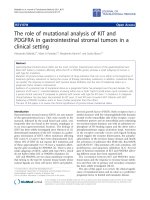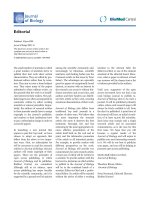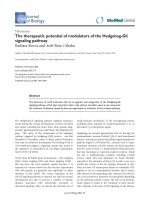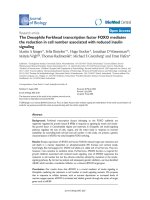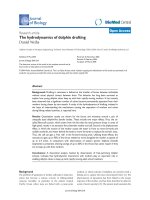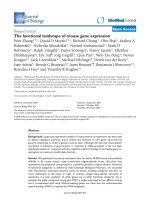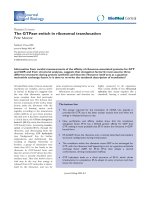Báo cáo sinh học: " The EADGENE Microarray Data Analysis Workshop (Open Access publication)" pdf
Bạn đang xem bản rút gọn của tài liệu. Xem và tải ngay bản đầy đủ của tài liệu tại đây (81.28 KB, 11 trang )
Genet. Sel. Evol. 39 (2007) 621–631 Available online at:
c
INRA, EDP Sciences, 2007 www.gse-journal.org
DOI: 10.1051/gse:2007028
Original article
The EADGENE Microarray Data
Analysis Workshop
(Open Access publicati on)
Dirk-Jan de Koning
a∗
,FlorenceJaffr
´
ezic
b
, Mogens Sandø
L
und
c
, Michael Wat s on
d
, Caroline Channing
a
,InaHulsegge
e
,
Marco H. P
ool
e
,BartBuitenhuis
c
,JakobHedegaard
c
,Henrik
H
ornshøj
c
,LiJiang
c
, Peter Sørensen
c
, Guillemette Marot
b
,
Céline D
elmas
f
,Kim-AnhL
ˆ
e
Cao
f,g
, Magali San Cristobal
f
,
Michael D. B
aron
h
, Roberto Malinverni
i
, Alessandra Stella
i
,
Ronald M. B
runner
j
, Hans-Martin Seyfert
j
,KirstyJensen
a
,
Daphne M
ouzaki
a
,DavidWaddington
a
, Ángeles
J
im
´
enez-Mar
´
in
k
, Mónica P
´
erez
-Alegre
k
,Eva
P
´
erez
-Reinado
k
, Rodrigue Closset
l
, Johanne C. Detilleux
l
,
Peter D
ov
ˇ
c
m
,MihaLav r i
ˇ
c
m
, Haisheng Nie
n
,LucJanss
c
a
Roslin Institute, Roslin, UK
b
INRA, UR337, Jouy-en-Josas, France
c
University of Aarhus, Tjele, Denmark
d
Institute for Animal Health, Compton, UK
e
Animal Sciences Group Wageningen UR, Lelystad, The Netherlands
f
INRA, UMR444, Castanet-Tolosan, France
g
Université Paul Sabatier, Toulouse, France
h
Institute for Animal Health, Pirbright, UK
i
Parco Tecnologico Padano (PTP), Lodi, Italy
j
Research Institute for the Biology of Farm Animals, Dummerstorf, Germany
k
University of Córdoba, Córdoba, Spain
l
University of Liege, Liege, Belgium
m
University of Ljubljana, Ljubljana, Slovenia
n
Wageningen University and Research Centre, Wageningen, The Netherlands
(Received 10 May 2007; accepted 3 July 2007)
Abstract – Microarray analyses have become an important tool in animal genomics. While
their use is becoming widespread, there is still a lot of ongoing research regarding the analysis
of microarray data. In the context of a European Network of Excellence, 31 researchers repre-
senting 14 research groups from 10 countries performed and discussed the statistical analyses
∗
Corresponding author:
Article published by EDP Sciences and available at
or />622 D J. de Koning et al.
of real and simulated 2-colour microarray data that were distributed among participants. The
real data consisted of 48 microarrays from a disease challenge experiment in dairy cattle, while
the simulated data consisted of 10 microarrays from a direct comparison of two treatments
(dye-balanced). While there was broader agreement with regards to methods of microarray nor-
malisation and significance testing, there were major differences with regards to quality control.
The quality control approaches varied from none, through using statistical weights, to omitting
a large number of spots or omitting entire slides. Surprisingly, these very different approaches
gave quite similar results when applied to the simulated data, although not all participating
groups analysed both real and simulated data. The workshop was very successful in facilitating
interaction between scientists with a diverse background but a common interest in microarray
analyses.
gene expression / two colour microarray / statistical analysis
1. INTRODUCTION
The recent development of high throughput gene-expression technologies,
such as microarrays, has given rise to a plethora of new research hypothe-
ses and possibilities. Extensive reviews are available about the application [3],
design [6], and analysis [12] of microarray studies. In livestock, microarrays
have been proposed to study gene-expression in the parasite (Malaria [13];
Trypanosomosis [8]) as well as host response following infection (e.g. My-
cobacterium paratuberculosis infection in cattle [7]; Eimeria infection in poul-
try [11]). Other applications in livestock include the evaluation of the effects
of diet on gene expression in beef cattle [4] and gene expression differences
related to differences of muscling in pigs [5].
In a recent review, Allison et al. outline the areas of consensus and out-
standing questions with regards to microarray analysis [2]. Some points of
consensus regarding data analysis as presented by those authors [2] were the
following: (1) many methods exist for the pre-processing (normalisation, etc.)
of two-colour microarrays, but there is no clear winner and none were dis-
cussed in detail; (2) using fold-change alone as a test for differential expres-
sion is inefficient; (3) false discovery rate is a good alternative to conventional
multiple testing; and (4) unsupervised classification is overused and should be
validated using re-sampling techniques. The most relevant outstanding ques-
tions were [2] the following: (1) the best image processing algorithm; (2) the
evaluation of data quality; and (3) the assessment of intersections between sets
of findings within and between experiments.
Given the lack of consensus in many areas, especially for the two-colour
arrays that are abundant in livestock research, we organised a workshop on the
analysis of microarrays. Conferences dealing with the statistical analyses of
EADGENE Microarray Data Analysis Workshop 623
microarrays using common sets of data have been successfully organised annu-
ally in the United States since 2000 [10] ( These
conferences have been large scale events, attracting 250 or more participants.
In contrast, the present workshop was limited to 35 participants to maximise
interaction and focussed on microarray experiments in the context of the ge-
netics of host-pathogen interaction in livestock. The workshop was organised
through the EC-funded network of excellence (NoE) EADGENE (European
Animal Disease Genetics Network of Excellence for Animal Health and Food
Safety; o/).
2. WORKSHOP GOALS
The main aim of the workshop was to bring together scientists from within
the EADGENE network with an interest in microarray analyses and to facil-
itate interaction and future collaboration between these scientists. In order to
focus the discussions, the workshop was organised around two sets of data, real
and simulated, that were distributed among the participants prior to the work-
shop. The methods of analysis, the interpretation of results and how to use
the (quite complex) real experimental design were left to the participants. This
was advantageous as it led to very different approaches by different groups.
The diversity of approaches was a major contributor to our ability to identify
outstanding questions in the treatment of microarray data.
The statistical aspects of a microarray study include the design of the study,
the quantification of the hybridisation intensities, the pre-processing and nor-
malisation of data, the inference and classification of results, the biological in-
terpretation and finally the validation of differentially expressed genes as well
as other follow-up studies. For practical reasons this workshop only dealt with
the following aspects of microarray analysis: (1) some of the pre-processing
of the raw microarray intensities (mainly quality control); (2) normalisation of
the microarray data; (3) the detection of differentially expressed genes; (4) the
clustering and classification analyses of the differentially expressed genes as
well as the biological interpretation (real data only).
The workshop format allowed comparison of results for a real microarray
experiment that was relevant to the remit of EADGENE as well as simulated
data with known parameters, which facilitated a comparison of performance
between groups. However, it must be stressed that the interaction among sci-
entists, facilitated through common data sets, was the main objective.
624 D J. de Koning et al.
Table I. Overview of workshop participants and acronyms used to describe the groups
throughout the four articles.
Acronym Affiliation Group Real Simulated
size data data
AARHUS University of Aarhus, Tjele, Denmark 6 x
CDB University of Córdoba, Spain 3 x
IAH_C Institute for Animal Health, Compton, UK 1 x
IAH_P Institute for Animal Health, Pirbright, UK 1 x
IDL Animal Sciences Group Wageningen UR, 2 x x
Lelystad, NL
INRA_J INRA, Jouy-en-Josas, France 3 x x
INRA_T INRA, Castanet-Tolosan, France (8, 6)
a
x(8) x(6)
ULg University of Liege, Liege, Belgium 2 x 1
b
x
PTP Parco Tecnologico Padano, Lodi, Italy 3 x
RIBFA Research Institute for the Biology of Farm Animals, 5
c
x
Dummerstorf, Germany
ROSLIN Roslin Institute, Roslin, UK 4 x x
SLN University of Ljubljana, Slovenia 2 x x
WUR Wageningen University and Research Centre, NL 2 x
a
This group included six members for the analysis of simulated data (four from INRA-Station
d’amélioration génétique des animaux and two from INRA-Laboratoire de génétique cellulaire)
and eight members for the analysis of real data (four from INRA-Station d’amélioration géné-
tique des animaux, three from INRA-Laboratoire de génétique cellulaire and one from the Paul
Sabatier University).
b
Two members from different groups within the University of Liege analysed and presented
independently.
c
This group included two members from Ludwig-Maximilian University in München, and one
member of the University of Veterinary Medicine in Hannover.
3. THE WORKSHOP PARTICIPANTS
The data was analysed by 42 participants, representing 14 research
groups from 11 EADGENE partners. During a 3-day workshop, attended by
31 participants, all groups presented and discussed their findings. The details
of the different groups as well as their acronym and group sizes are presented
in Table I. While all participants had shared interests through their involve-
ment in EADGENE, they had varying levels of experience in the analyses of
microarray data and different interests in taking part.
Some participants were routinely involved in the analyses of microarrays in
their own institutes while others were using this workshop to gain ‘hands-on’
experience with the analyses of microarray data. Some groups had developed
sophisticated tools to deal with a specific aspect of microarray analyses and
used the workshop to demonstrate or test-drive their approach. Because the
EADGENE Microarray Data Analysis Workshop 625
real data was from a mastitis experiment, some participants had a particular
interest in this disease and its study via microarray analyses.
The detailed results on the analyses of the real data are given by Jaffrézic
et al. [9] for the quality control, the normalisation and statistical testing and
Sørensen et al. [14] for the multiple gene analyses. The detailed results of the
simulated data analyses are presented by Watson et al. [15].
4. OVERVIEW OF DATA
4.1. Real data
The real data consisted of 48 microarrays from an artificial infection ex-
periment in dairy cattle with several time points and two different infectious
agents: Escherichia coli and Staphylococcus aureus.
For further details on the experimental procedures see Jaffrezic et al. [9].
The microarray experiment was carried out using the Bovine 20K
array (ARK-Genomics: A reference de-
sign, without dye-swap, was used and the reference sample was made
up of a pool of all 48 RNA samples. The resulting microarrays
were scanned and data were extracted using BlueFuse (BlueGnome,
No further adjustments
or normalisations were made to these data prior to distribution to the partici-
pants. The distributed data included an automated annotation of the microarray
provided by Mark Fell (Roslin Institute).
4.2. Simulated data
The microarray data were simulated using Simage [1] (http://bioinformatics.
biol.rug.nl/websoftware/simage/simage_start.php). This provides a menu-
driven interface in which the user can define gene effects as well as numerous
noise factors. Using “Simage-R Parameter” we estimated summary statistics
from a randomly selected microarray slide from the real data and used this to
simulate 10 slides of a direct comparison (A ver sus B) where every second
slide had treatments reversed for dyes. Although the parameter settings for the
simulated data were derived from a real microarray, a lot of noise was added to
really test the QC and normalisation approaches of the various groups. From
the 2400 genes that were simulated, 624 were differentially expressed (264 up
regulated from A to B and 360 down regulated).
626 D J. de Koning et al.
4.3. Differences between real and simulated data
While the simulated data provided a simple A versus B comparison, the real
data had the components of time and type of bacteria that were used to infect
the cows. The researcher could ask different questions: e.g. which genes are
differentially expressed following infection with a specific pathogen? At what
time post infection is the differential expression most prominent? What genes
are only differentially expressed following infection with one pathogen and not
the other? Although unintended as a discussion area for the workshop, the real
data did illustrate a problem in experimental design, which was not discovered
by a pilot experiment, namely the dependence in gene expression between the
udder quarters in the real data.
The results from the workshop may at first glance seem contradictory: the
real data results were quite different between groups (both in numbers of dif-
ferentially expressed genes and gene order) [9] while the results from the sim-
ulated data indicate that most of the approaches gave good and comparable
results [15]. It could be argued that methods that give similar results for sim-
ulated data should give similar results for real data, if the two sets of data are
comparable. The difference between the results from real and simulated data
is most likely due to differences in the expected statistical power to detect dif-
ferentially expressed genes between the two sets of data: while the real data
consisted of 48 microarrays, any comparison between two time points within
an infection had only four microarrays contributing to each time point, while
the contrast was indirect via a reference design. The simulated data consisted
of 10 microarrays for a direct A versus B comparison making it more powerful
than the comparisons within the real data. It could be argued retrospectively
that for comparison of methods the real data had too little power and too many
possible scenarios to be tested, while the simulated data had too much power
to reveal subtle differences between methods. This emphasises the benefits of
this kind of workshop, since this finding was only apparent after combining
and contrasting the approaches and results of the different groups, and the ob-
servation will be fed forward into future workshops.
In the simulated data only two levels of differential expression were simu-
lated: one for up-regulated genes and one for the down-regulated genes. Even
so, the mixture model distributions of test statistics showed that the various
noise contributions produced symmetrical distributions for the up and down
regulated genes. The simulated data was notably different from real data [15],
but still allowed valuable comparisons of approaches to analysis. The simu-
lated data did confirm that when the power of an experiment is high, many
of the specific differences between the methods that are applied may become
EADGENE Microarray Data Analysis Workshop 627
less crucial, provided that they deal adequately with high levels of technical
bias or noise. At the same time, many microarray experiments have moderate
to low power and hence comparison of methods on the basis of real data has
considerable merit.
5. QUESTIONS, CONSENSUS, AND RECOMMENDATIONS
5.1. Quality Control (QC)
The approaches presented during the workshop showed most divergence at
the QC stage. In terms of QC of the real data, several groups used the spot
quality indicators provided by the scanning software (Bluefuse) to make deci-
sions about excluding spots from the analysis. Other groups indicated that they
would normally take account of background intensities for quality control but
Bluefuse does not use a measure of background intensity from pixels around
the spot, nor does it make an explicit estimate from within-spot pixels, and
therefore the background intensities were not provided for the real data. One
group re-estimated background from the data provided and used ratios between
signal and inferred background to exclude bad spots while another group ex-
cluded spots on the basis of absolute intensity (mainly for the simulated data).
Further to omitting bad spots based on quality indicators or (relative) intensity,
some groups omitted entire slides from further analyses based on QC criteria.
As an alternative to using quality indicators to include or omit spots from fur-
ther analyses, one group used quality indicators as statistical weights in both
normalisation and analysis of the microarrays.
The different approaches for QC led to some groups omitting no spots at
all while other groups omitted many spots and even entire slides (up to two or
three slides for the simulated data). Removing spots from subsequent analyses
often renders the statistical model unbalanced and reduces the degrees of free-
dom, and hence the power of the test for a single gene. The effect of removing
spots on normalisation, shrinkage of gene variance and multiple testing may
counterbalance the loss of power, but these effects are less predictable. There-
fore, approaches that utilise all spots but account for different quality of spots
deserve further attention.
Another point of discussion was when to apply the QC: It was argued that
outlier spots can only be identified after normalisation has taken account of
spatial effects but the counter argument was that spots with saturated intensity
measurements would bias the normalisation and should be removed before
normalisation. It was suggested that QC should be applied at several stages of
628 D J. de Koning et al.
the analyses but this was not implemented by any of the groups. Although QC
was widely debated during the workshop, we did not define a ‘best practise’
for QC, although we can make a recommendation to evaluate the effect of
various levels of spot editing. Again, the benefits of the workshop are shown
by the unexpected identification of QC and data editing as critical factors for
discussion and further study. Many publications concentrate on the statistical
analysis of simulated or established datasets. While comparison showed that
the statistics are generally well understood or accepted; how real experimental
data is pre-processed remains a matter for further study.
5.2. Normalisation, significance testing and multi-gene analyses
For the normalisations, many groups removed intensity related bias (when
the relationship between average intensity and the ratio between the two colour
intensities is non-linear) by LOWESS (or LOESS) regression. One group did
additional spatial smoothing while few groups included across-slide normali-
sation. The latter is emphasised in the results for the simulated data [15] as a
way of making slides more comparable, especially for the noisy data in this
study. The gene expression contrasts were mainly estimated using linear mod-
els or mixed linear models with various approaches to shrink the gene variance
prior to significance testing. To address the multiple testing issues, most groups
used some variant of the false discovery rate (FDR) but there were also some
standard and novel approaches based on mixture distributions. The main prob-
lem of comparing gene lists between groups is that it could not be determined
what stage of the different analysis pipelines caused the results to differ.
The only three approaches that performed very poorly in detecting differ-
entially expressed genes in the simulated data was one approach based on
fold-changes only, and two using ANOVA combined with the lowest level of
normalisation – chip median correction. Because of the prominent print-tip
effects in the simulated microarray data, failure to account for these will re-
sult in many spurious effects when using only chip-median correction and/or
analysing fold-changes only [15].
With regards to the recent review by Allison et al. [2], the workshop echoed
the points regarding the current lack of agreement in pre-processing (although
the main differences were in QC rather than normalisation), in particular that
fold-changes are not good criteria, and that the FDR, as well as some other
novel multiple testing approaches, provide an attractive alternative to conven-
tional multiple testing strategies. We did not address the outstanding questions
EADGENE Microarray Data Analysis Workshop 629
on image processing algorithms because we only used results from a single
processing algorithm for the workshop.
The multi-gene analyses were too diverse for a meaningful comparison al-
though some trends are described by Sørensen et al. [14]. Those analyses that
were aimed at assigning biological meaning to the differentially expressed
genes were hampered by the limited annotation that was available for the
clones on the microarray. This will improve over time with the ongoing an-
notation of the cow genome sequence.
5.3. Recommendations
While the participants agreed that the workshop had been very useful, we
also debated recommendations for potential future workshops on the same
topic. The following recommendations were made: (1) Provide different levels
of pre-processed data for different analyses. You can provide raw image files
to compare image processing algorithms, while you also provide normalised
data to compare different models to obtain gene lists or to compare different
clustering approaches. Likewise, when comparing bioinformatics tools for the
biological interpretation of microarray results, you provide a pre-set common
gene list, preferably for a model species with good bioinformatics resources.
(2) Ask participants to analyse specific contrasts or scenarios. For the present
workshop, we gave real data on 48 slides as well as experimental details, but
the participants could decide on what part of the data they would use and what
contrasts they would estimate. (3) Simulate microarrays that are more simi-
lar to real data and if possible, include a range of gene effects and variances
as well as a correlation structure among genes. (4) Because of limited pre-
sentation time at the workshop, some details of the analyses were missed, in
particular analyses that were initially done, but not carried further. One op-
tion is to have a pre-meeting participant survey that includes what approaches
were tested and how they performed. Other ways of having a more uniform
reporting structure among groups may also benefit the comparisons.
6. CONCLUSIONS
The workshop succeeded in its main aim of sharing expertise and experience
among statisticians and biologists using microarrays in livestock research. At
least one group used it as a starting point to re-visit their own data analysis
pipeline in the view of analyses and expectations of other groups. Furthermore,
the three companion papers with details on the various analyses and results will
630 D J. de Koning et al.
provide pointers for colleagues in the wider community regarding the options
available for microarray analyses [9, 14, 15].
While a direct comparison of results between groups remained challenging,
it was extremely useful to discuss microarray analyses on the basis of two com-
mon data sets. In many conferences or workshops, participants only present
their own data and hence any conclusions about methods cannot be separated
from the experiments to which these methods were applied. The joint analyses
of the same data that was done during the workshop will also have added value
to the original experiment. Furthermore, the workshop is not an endpoint but
the starting point of new collaborations among researchers analysing microar-
ray data but also between these researchers and biologists that ultimately give
meaning to the results.
ACKNOWLEDGEMENTS
The organisers acknowledge local support from the University of Aarhus
colleagues, in particular Karin Smedegard. We greatly appreciate the data con-
tributed to the workshop by Hans-Martin Seyfert, the analysis done by Kirsty
Jensen and all the work included of their colleagues. For the simulated data,
we acknowledge early access to Simage thanks to Ritsert Jansen and his group.
The workshop was organised and financially supported by EADGENE (EU
Contract No. FOOD-CT-2004-506416).
REFERENCES
[1] Albers C.J., Jansen R.C., Kok J., Kuipers O.P., van Hijum S.A., SIMAGE: simu-
lation of DNA-microarray gene expression data, BMC Bioinformatics 7 (2006)
205.
[2] Allison D.B., Cui X., Page G.P., Sabripour M., Microarray data analysis: from
disarray to consolidation and consensus, Nat. Rev. Genet. 7 (2006) 55–65.
[3] Butte A., The use and analysis of microarray data, Nat. Rev. Drug Discov. 1
(2002) 951–960.
[4] Byrne K.A., Wang Y.H., Lehnert S.A., Harper G.S., McWilliam S.M., Bruce
H.L., Reverter A., Gene expression profiling of muscle tissue in Brahman steers
during nutritional restriction, J. Anim. Sci. 83 (2005) 1–12.
[5] Cagnazzo M., te Pas M.F., Priem J., de Wit A.A., Pool M.H., Davoli R., Russo V.,
Comparison of prenatal muscle tissue expression profiles of two pig breeds dif-
fering in muscle characteristics, J. Anim. Sci. 84 (2006) 1–10.
[6] Churchill G.A., Fundamentals of experimental design for cDNA microarrays,
Nat. Genet. 32 (Suppl.) (2002) 490–495.
EADGENE Microarray Data Analysis Workshop 631
[7] Coussens P.M., Jeffers A., Colvin C., Rapid and transient activation of gene ex-
pression in peripheral blood mononuclear cells from Johne’s disease positive
cows exposed to Mycobacterium paratuberculosis in vitro, Microb. Pathog. 36
(2004) 93–108.
[8] El Sayed N.M., Hegde P., Quackenbush J., Melville S.E., Donelson J.E., The
African trypanosome genome, Int. J. Parasitol. 30 (2000) 329–345.
[9] Jaffrézic F., de Koning D.J., Boettcher P.J., Bonnet A., Buitenhuis B., Closset
R., Déjean S., Delmas C., Detilleux J.C., Dov
ˇ
c P., Duval M., Foulley J L.,
Hedegaard J., Hornshoj H., Hulsegge I., Janss L., Jensen K., Jiang L., Lavri
ˇ
c
M., Lê Cao K A., Lund M.S., Malinverni R., Marot G., Nie H., Petzl W., Pool
M.H., Robert-Granié C., San Cristobal M., van Schotshorst E.M., Schuberth H
J., Sørensen P., Stella A., Tosser-Klopp G., Waddington D., Watson M., Yang W.,
Zerbe H., Seyfert H M., Analysis of the real EADGENE data set: Comparison
of methods and guidelines for data normalisation and selection of differentially
expressed genes., Genet. Sel. Evol. 39 (2007) 633–650.
[10] Johnson K., Lin S., Call to work together on microarray data analysis, Nature
411 (2001) 885.
[11] Min W., Lillehoj H.S., Kim S., Zhu J.J., Beard H., Alkharouf N., Matthews B.F.,
Profiling local gene expression changes associated with Eimeria maxima and
Eimeria acervulina using cDNA microarray, Appl. Microbiol. Biotechnol. 62
(2003) 392–399.
[12] Quackenbush J., Microarray data normalization and transformation, Nat. Genet.
32 (Suppl.) (2002) 496–501.
[13] Rathod P.K., Ganesan K., Hayward R.E., Bozdech Z., DeRisi J.L., DNA mi-
croarrays for malaria, Trends Parasitol. 18 (2002) 39–45.
[14] Sørensen P., Bonnet A., Buitenhuis B., Closset R., Déjean S., Delmas C., Duval
M., Glass L., Hedegaard J., Hornshoj H., Hulsegge I., Jaffrézic F., Jensen K.,
Jiang L., de Koning D.J., Lê Cao K A., Nie H., Petzl W., Pool M.H., Robert-
Granié C., San Cristobal M., Lund M.S., van Schotshorst E.M., Schuberth H J.,
Seyfert H M., Tosser-Klopp G., Waddington D., Watson M., Yang W., Zerbe H.,
Analysis of the real EADGENE data set: Multivariate approaches and post anal-
ysis, Genet. Sel. Evol. 39 (2007) 651–668.
[15] Watson M., Pérez-Alegre M., Baron M.D., Delmas C., Dov
ˇ
c P., Duval M.,
Foulley J L., Garrido-Pavón J.J., Hulsegge I., Jaffrézic F., Jiménez-Marín Á.,
Lavri
ˇ
c M., Lê Cao K A., Marot G., Mouzaki D., Pool M.H., Robert-Granié C.,
San Cristobal M., Tosser-Klopp G., Waddington D., de Koning D.J., Analysis of
a simulated microarray dataset: Comparison of methods for data normalisation
and detection of differential expression., Genet. Sel. Evol. 39 (2007) 669–683.
